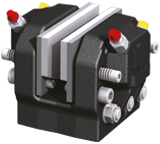Hydraulic Brakes Information
 Hydraulic brakes use the incompressible fluid properties to actuate a braking mechanism and provide the braking components (discs, drums, pads, etc.) with force to engage and remove energy from a moving system. Brakes differ from one to the next in the way they engage, operate, and perform. All hydraulic brake systems require a closed hydraulic system consisting of an actuated (master) cylinder that moves the hydraulic fluid through hydraulic lines and forces the brake cylinders to move, actuating the braking device. Braking systems can range in size from a simple hand lever operated brake on a snowmobile to complex, power assisted systems found in large industrial equipment and construction vehicles.
Hydraulic brakes use the incompressible fluid properties to actuate a braking mechanism and provide the braking components (discs, drums, pads, etc.) with force to engage and remove energy from a moving system. Brakes differ from one to the next in the way they engage, operate, and perform. All hydraulic brake systems require a closed hydraulic system consisting of an actuated (master) cylinder that moves the hydraulic fluid through hydraulic lines and forces the brake cylinders to move, actuating the braking device. Braking systems can range in size from a simple hand lever operated brake on a snowmobile to complex, power assisted systems found in large industrial equipment and construction vehicles.
Specifications
Performance specifications to consider while selecting a hydraulic brake include, but are not limited to:
- Torque Rating—The maximum torque rating for the brake should equal or exceed the application's requirement.
- Power—The maximum power rating for the brake.
- Speed—The maximum rotary speed rating. This specification applies only to rotary brakes.
- Maximum Pressure—The maximum pressure for a hydraulic brake.
- Shaft Configuration—Brake may be mounted in-line, parallel, or right angle.
Types
Energy can be removed by a brake in several ways. Here are some different approaches to braking:
- Band—Band brakes are the simplest type of brake. They have a metal band lined with heat- and wear-resistant friction material.
- Drum—Drum brakes press shoes against a spinning surface. They are often used on automobile rear wheels.
- Disc—Disc brakes have brake pads, a caliper, and a rotor. During operation, the brake pads are squeezed against the rotor. Disc brakes have good heat dissipation properties.
- Cone—Cone brakes consist of a cup and a cone that is lined with a heat- and wear-resistant friction material. During actuation, the cone is pressed against the mating cup surface. Cone brakes are not commonly used.
Several engagement methods are available for hydraulic brakes, including:
- Noncontact—Braking action is achieved through a non-contact technology such as a magnetic field, eddy currents, etc.
- Friction—Friction between contact surfaces transmits power. This is the most common type of brake.
- Toothed—Toothed contact surfaces transmit power without slipping or heat generation. Teeth are engaged only when stopped or running at a slow speed (< 20 rpm).
- Wrap Spring—A coiled spring wraps downward onto the rotating element. The brake is disengaged when the spring is uncoiled via a control tang at its end.
- Oil Shear—Braking action is engaged via the viscous action of the shearing of transmission fluid.
Features
There are two brake operation methods for hydraulic brakes: spring actuation (engage) and spring return (disengage):
- Spring Actuation/Engage—The spring engages during operation and requires power to disengage. Spring-actuated brakes are also called power-off brakes, fail-safe brakes, and safety brakes.
- Spring Return/Disengage—The brakes need power to engage. A spring is used to disengage the brake. Spring-return brakes are also called power-on brakes and non-fail-safe brakes.
Applications
Though Hydraulic Brakes are most familiar to us as they are used in our cars, they are present in many other transportation and rolling stock industries such as aerospace, heavy transport, marine, and off-highway. Hydraulic brakes are also found in industrial equipment like conveyors, machine tools, motors, pumps, robotics, and automation. Hydraulic brakes are significantly easier to modulate than mechanical brakes; you get more force delivered to the pads, and, as a result, more stopping power for the same input. Additionally, you will experience faster and more consistent pad withdrawal upon release.
Related Information
Engineering360—Engineer's Guide to Hydraulic Oils and Transmission Fluids
Image credit:
Dellner Brakes
- hydraulic disc brake
- mechanical drum brakes
- air brake clutch brake system
- vacuum over hydraulic brake
- weston brake
- air assisted hydraulic brakes
- crane drum brakes
- electromagnetic drum brakes
- hoist drum brakes
- hydraulic released brake calipers
- multi disc hydraulic brakes
- self servo action drum brakes
- spring released brake calipers
- winch drum brakes
- winch hydraulic brakes
